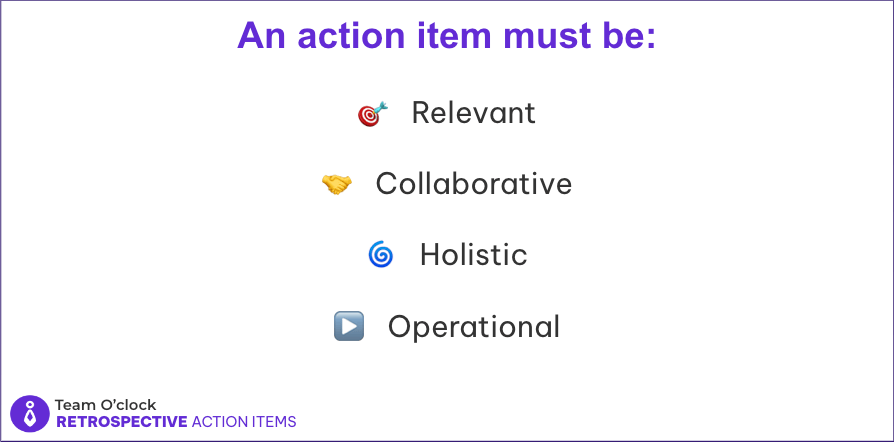
Mastering Action Items: Key Strategies for Effective Retrospective Outcomes

The retrospective meeting is an agile meeting that closes the loop of an iteration or sprint cycle. Teams in a retrospective share all notes that each team member considers important, identify patterns, and single out items to grow as a team.
In the following sections, we will explore how to support team growth through action items, the significant step in a continuous improvement journey.
Introduction to Action Items in Agile Practices
Action items highlight the tasks a team should do to improve the most important challenges the whole team is currently facing. Based on this definition, an action item is:
Relevant, as it involves a challenging topic that the team is currently facing.
Collaborative, since any related action requires the whole team to perform or validate it.
Holistic, as it carries the importance weight of all members that built the action item.
Operational, as it drives action to make it happen.

The above characteristics of an action item make it the perfect tool for continuous team improvement.
There is a positive feedback loop as the team keeps resolving action items. With each new accomplishment - action item resolution - the whole team gets the benefits while feeling happy for identifying and acting upon a common challenge. Finally, action items are a team bonding mechanism aligning members to the common goal; team growth.
The Process of Identifying Action Items
A good action item is the result of an effective retrospective meetings. To run an effective retrospective meeting all team members need to:
Be mindful of the retrospective process and the period in question
Feel safe to share their notes and meeting points
Be honest when sharing notes and having a discussion
Be respectful, the goal is team improvement without individual blaming or pointing fingers!
Communicate with clarity their concerns so that all other members understand the points
As all members follow these guidelines, the most important meeting points will stand out. As team members have an honest discussion - still following the above guidelines - important action items will emerge.
While discussing as a team keep in mind to:
Give everyone a chance to speak, to include all perspectives. This is important, especially in teams with diverse skills and specialties.
Keep the discussion within boundaries. Don't start ideation and brainstorming outside your area of influence; your team.
Timebox your discussion, so that you don't end up in endless discussions without a resolution.
Ask the "What's next?" question, to align everyone towards a resolution and steps moving forward.
While the above guidelines and tips stand true for all meetings, they are vital in driving your team to create effective action items.
A final tip is to leverage the voting aspect of the retrospective into picking the most important notes to discuss; those are the most voted notes. Focus on the three to four most-voted meeting points, and discuss to create action items for the current challenges.
Prioritizing Action Items for Impact
Discussing the most important notes, the team usually has some ideas to translate each note into an action item, or you can leverage tools to help you.
If all members feel safe sharing their notes and having an honest talk, creating the action items comes naturally and usually very fast into the discussion. Since everyone talks about the most challenging and relevant parts of their day-to-day interactions action items flow naturally.
As the discussion and action items unfold be mindful of the number of action items you produce as a team. Staying focused and playing the long game applies to action items too. Spreading your team growth efforts too thin with many action items raises the bar too high and members can easily get demotivated.

There is no reason to generate more than 3 action items if you have a retrospective every month. If you have a retrospective once a year adding more action items will be fine, as long as the team can manage progress.
One last thing, the retrospective meeting promotes openness and discussion. Remember that there will be occasions when no action items will come out of a retrospective.
Having no action items is an acceptable outcome of a retrospective as long as the team talks about the important items, reaching a common understanding and acknowledgment of the team's status. For a retrospective with no action items, it is important to track all team notes.
Action Items Follow-up in the Daily Team Operations
Building the right action items will bring your team halfway there; following up on these action items makes the team grow. When it comes to timeframes for completing action items, there are two categories:
Ongoing/Reminder action items the team should keep in mind while performing their daily tasks. These action items refer to habits or ways to interact with other teams. The responsibility of applying an ongoing action item falls to the whole team. Everybody can recall the action item and share it with the rest of the team when it becomes relevant. Working as a team and reminding others of action items decided during a retrospective builds more faith and alignment with the team's growth journey.
One-off action items are carried out once for completion. One-off action items usually involve documenting a process, discussion with another team on a common topic, or automating a process. The best way to complete a one-off action item is by assigning it to a team member.
For both categories, the team decides when an action item is resolved. Engaging the team in action item resolution helps align all members into acknowledging the same progress.
The 3 most common ways to resolve action items are:
Review open action items while in a retrospective. The best time to talk about open action items is after adding new action items to your retrospective. The team is already in the zone, discussing internal processes and areas for improvement. Reviewing previous open action items and recognizing your progress - as a team - enhances the feeling of collaboration and alignment.
Link action items to your tracking tool of choice, by automatically creating and assigning a task to a team member. This way you leverage the tracking mechanisms of your existing tracking tool. The assigned member can follow up with any progress or resolution of the action item directly on the assigned ticket, whether that is Jira, Asana, Linear, or any other tool your team uses.
Use weekly or monthly reminders to check in your action items' progress. Reminders come in many forms, either directly in your calendar, your favorite work chat app remind-me action, or via email in the agile meetings tool you use.
A Personal note from the author: "Please, highlight your Action Item Outcomes!"
Completed action items have accumulative benefits for the team. These benefits are consistently visible in the team's performance and growth in time.
A team following the good habits of retrospective and action item completion transforms greatly within a year. When you are caught up in daily tasks it is hard to realize the gradual improvements you and the team have achieved in long periods. It is like the parent who interacts daily with their child and fails to see how taller, or wiser the kid has grown within six months!
To see through this day-to-day growth and achievements, set a retrospective to review the team's last six months on a year's progress. In that retrospective, recall your action items from a year back, compare where the team was and is now, and highlight the overall status difference.









